What You Need to Know Before Visiting the Acropolis
Articles on this site contain affiliate links, meaning I may be compensated if you buy a product or service after clicking them. The full privacy & disclosure policy is here.Visible from almost anywhere in the downtown area, the Acropolis is as central to modern Athens as it was in its heyday nearly 1500 years ago. By far the biggest tourist attraction in the city, no visit is complete without ascending the hill to marvel at the Parthenon and all the other buildings and ruins that make up the site.
Unsurprisingly, then, the Acropolis sees plenty of visitors year-round, and becomes almost impossibly busy during tourist season. If you’re going there between mid-spring and mid-autumn (and despite the heaving crowds, you definitely should), a bit of forward planning will be the difference between an enjoyable visit and a miserable one.
With that in mind, my top tips for visiting the Acropolis are:
- Go as early as possible
- Don’t use the main entrance
- Buy your tickets in advance
- Pay attention to the opening hours
- Wear appropriate clothing
- Head straight to the top
- Don’t forget the museum
Here’s what you need to know.
The Best Time to Visit the Acropolis Is as Early as Possible
When the tourists are in town, roughly April through October, the best time to visit the Acropolis is as early as possible. In reality, that means you should aim to get there at least half an hour before opening time.
I can’t emphasise this enough. We visited in mid-September, and there was no shortage of visitors to Athens. Even so, we were almost the only people ascending the steps of the famous Propylaea (monumental gateway) at the top of the hill, following a fast walk from the entrance gate after it opened ten minutes earlier.
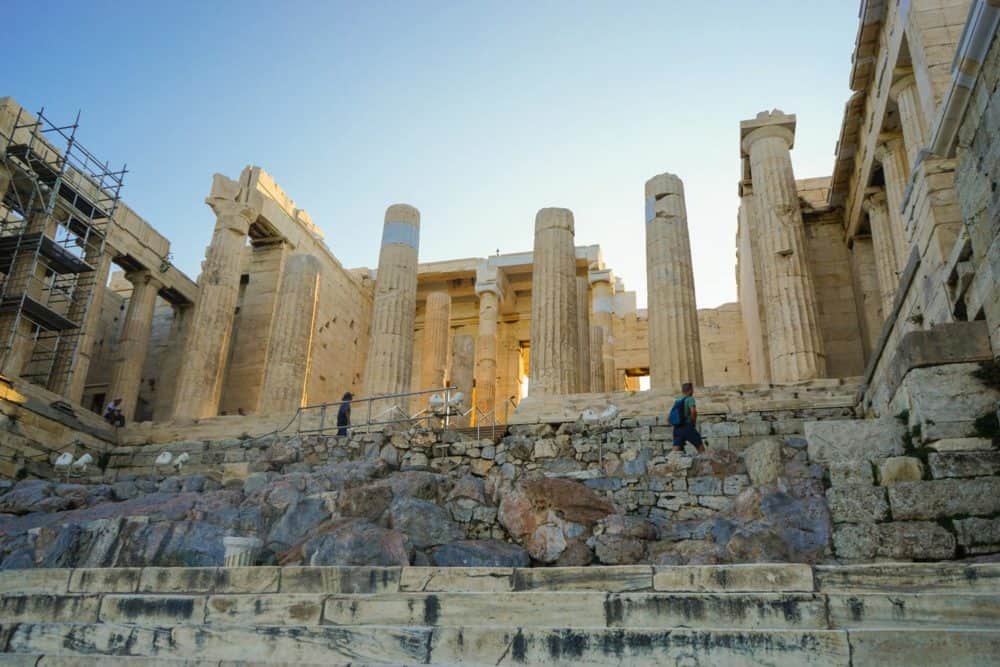
With the sun’s rays peeking through the columns of the Pantheon and just a few other people dotted around the sprawling site, it was one of those breathtaking, reflective moments that’s getting increasingly hard to find in the age of mass tourism.
No more than 20 minutes later, a vast wall of sound announced the arrival of the crowds. I’ve never experienced anything quite like it, and the ambiance instantly disappeared, replaced by a seething sprawl of humanity.
Hundreds upon hundreds of people swarmed through the entranceway, and even walking around became an ordeal. Tour leaders led their charges from building to building, flags waving as commentary in a dozen languages filled the silent spaces.
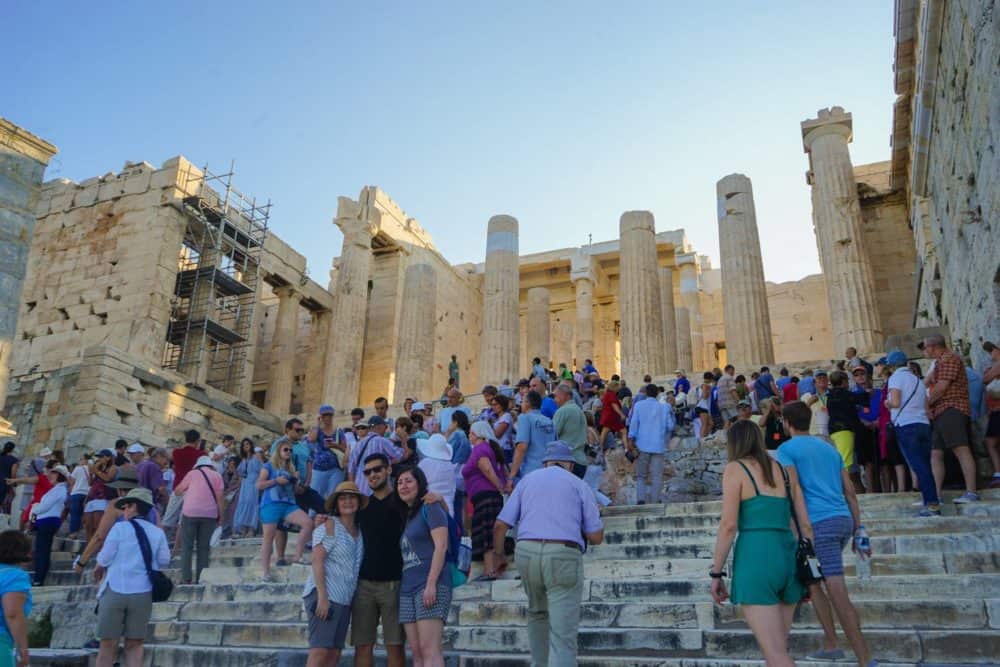
I left the hilltop not long afterward, sad I didn’t have longer to explore in solitude, but glad to have even the short time I got. If I’d lain in bed half an hour longer, I wouldn’t have.
Don’t Use the Main Entrance
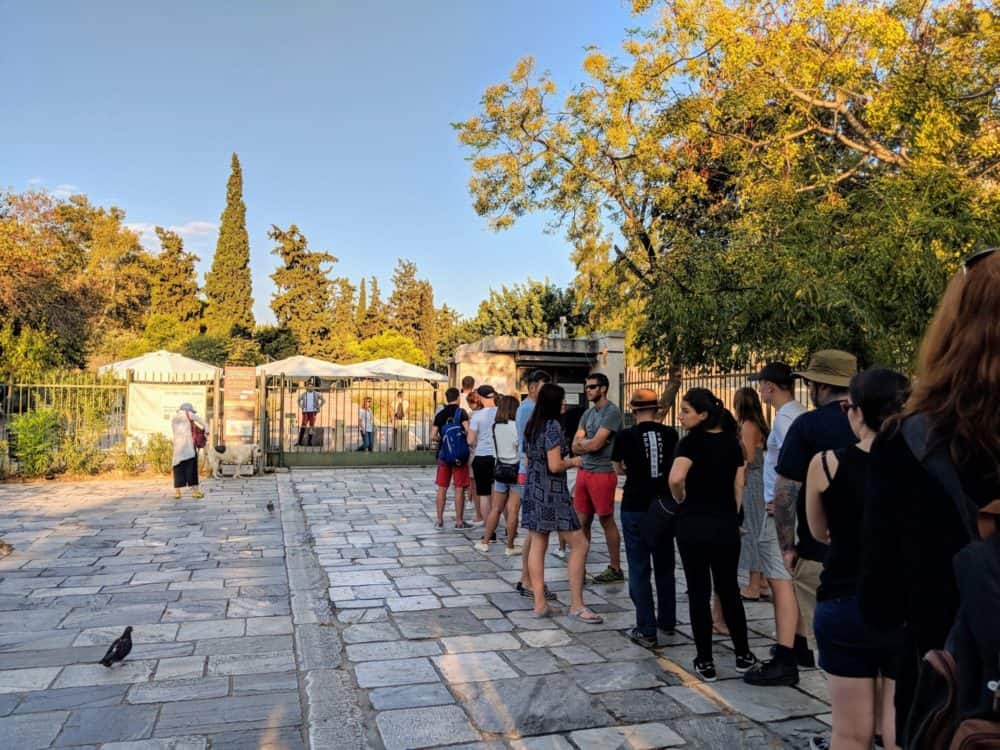
The Acropolis has two visitor entrances. The main one on Rovertou Galli is right beside the parking lot, and as a result, it’s the one used by tour groups. In summer, it’s not unusual to have to wait an hour or more in line there once the buses start rolling in.
Instead, enter via the ticket office at the southeast of the site, on Dionysiou Areopagitou near the Acropolis Museum. The climb to the top is fairly similar in length and difficulty to the other entrance, but everything is less chaotic, and the lines are usually much shorter.
The ticket office wasn’t marked on Google Maps at the time, but it is now. Coming from the east, if you get to the entrance of the Acropolis Museum, you’ve gone slightly too far.
Buy Your Acropolis Tickets in Advance
During the tourist season, the best way to skip the ticket line at the Acropolis is to simply pick up a multi-site ticket the day before. Costing €30 year-round, it gives access to several different historic sites in central Athens.
As well as the Acropolis, the combination ticket lets you enter the Ancient Agora, Hadrian’s Library, Kerameikos, Aristotle’s School, the Olympieion, and the Roman Agora, once each over a five-day period.
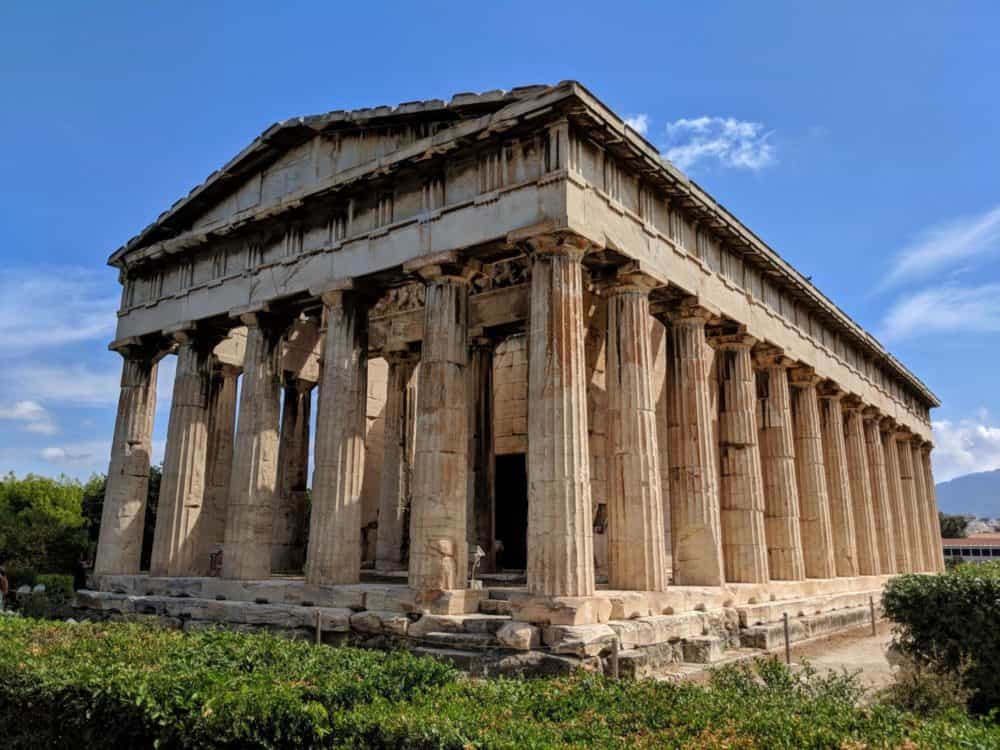
You can buy these tickets at any of the listed sites, all of the rest of which are far quieter than the Acropolis at any time of day. We bought ours at the Ancient Agora the previous morning, and visited several of the smaller sites throughout the afternoon.
When the gates opened at the Acropolis the next day, the line split into two. Those without tickets waited impatiently to buy them from the booth, while everyone who already had one simply scanned it at the turnstiles and walked straight through.
If you only want to see the Acropolis, a single full-price ticket costs €20 between April and October. It’s possible to buy these in advance for a few extra euros, which lets you skip the ticket line even without a multi-site pass.
If you want a physical ticket, you’ll need to exchange your voucher at a local travel agent’s office nearby before entering the Acropolis. If you’d prefer a mobile ticket, you can buy that in advance as well, and just show up at the gates.
If you’re planning on visiting some of the other historic sites as well, you can also buy the same multi-site pass that we used in advance instead of getting it in person on the day. Like I said, if you’re visiting one of those other sites first, there’s no great need to do so: the lines are usually quite short anyway. If you’re starting at the Acropolis, though, buy the pass before you go: it’s a mobile ticket, so you can print it out or scan it from your phone at the gates.
Just to be clear, having an advance ticket or multi-site pass only lets you skip the line for the ticket booth. If you arrive later in the day when there’s a line for the entry turnstiles as well, you’ll still need to wait in that unless you’ve opted for a guided tour.
Visiting the Acropolis in Winter
You’ll get 50% off the individual ticket price at all ancient sites during the winter months, but not the combination pass. Since the lines are shorter in winter anyway, you may as well save money and buy single passes as needed if that’s when you’re visiting.
50% discounts are also available year-round to seniors and non-EU students, with free entry for children under 18, EU students, people with significant disabilities, and others. Bring appropriate ID if you plan to claim one of these discounted tickets.
Free Entry to the Acropolis
Entrance is free on a few specific days each year, as below. I’d personally avoid visiting on those days since the crowds are even bigger than usual, but if you’re on a tight budget, it’s an option.
- 6 March
- 18 April
- 18 May
- The last weekend of September
- 28 October
- The first Sunday of the month from November through March
Pay Attention to the Opening Hours
The Acropolis has two different sets of opening hours, one for the summer season from the start of April until the end of October, and one for the winter season that covers the rest of the year.
In summer, the Acropolis is open from 08:00 a.m until 8:00 p.m each day. Plan to arrive by 7:30 a.m. to be close to the start of the line.
From November through March, the Acropolis is open from 08:30 a.m until 5:00 p.m. Although it’s not open for as long at this time of year, you’ve actually got more flexibility about when you go due to the reduced visitor numbers. No matter what time of year you visit, the last entry is half an hour before closing time.
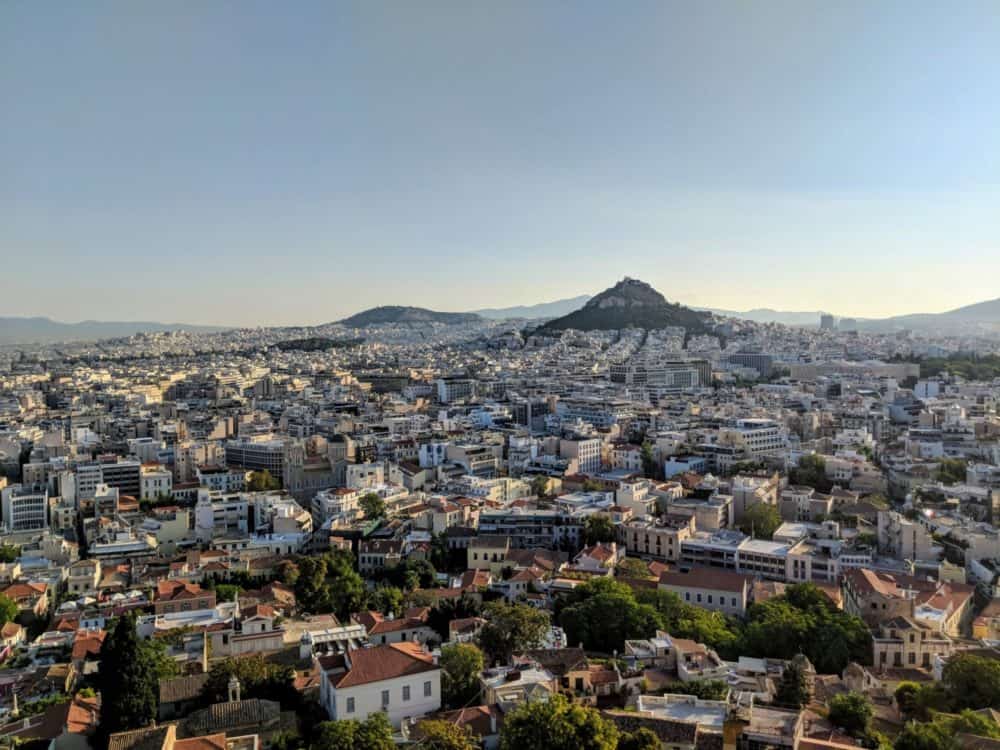
The Acropolis is closed entirely on many public holidays, as below. Double-check the hours ahead of time if you’re visiting on other public holidays as well.
- 1 January
- 25 March
- 1 May
- Easter Sunday
- 25 December
- 26 December
Wear Appropriate Clothing
Going early during the summer months has another advantage beyond beating the crowds: it beats the worst of the heat as well. It was relatively cool when we walked through the gates at 8:00 am, but by the time we left 90 minutes later, the sun was out in full force.
There’s no real shade or shelter on most of the site, and a single water fountain at the top that quickly gets very busy. Take plenty of water with you, along with appropriate sun protection.
If you’re there in winter, on the other hand, it can get cold, windy, and wet at the Acropolis. Warm clothing and a rain jacket are important at that time of year.
While most (although not all) of the areas where you can walk on the hilltop itself are relatively flat and well maintained, the same can’t be said for the paths that lead up there. No matter which direction you enter from, expect to encounter some uneven steps and rough ground along the way.
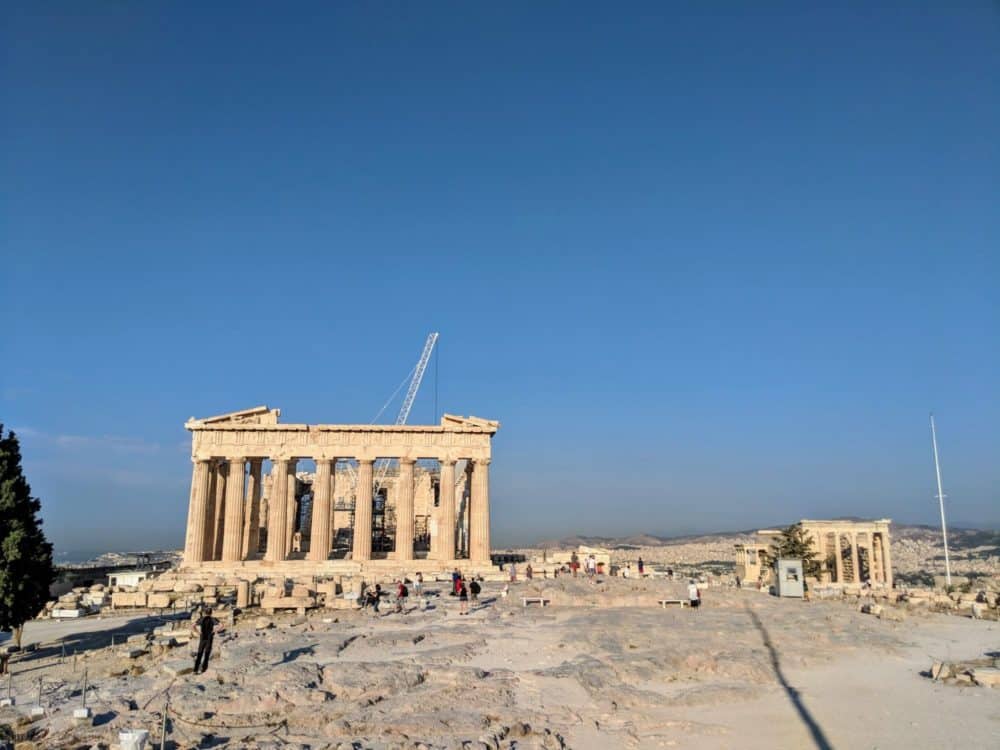
Ironically, when the ground isn’t rough, it can actually be too smooth. The weathered steps have been worn down by humans and the elements to a point where they’re often very slick, especially if there’s been any rain. It’s easy to slip!
As a result, whatever the weather, wear enclosed shoes with plenty of grip and padding. Sneakers with decent tread are much better than flip-flops or high heels. Proper walking sandals are likely ok as well, but don’t be surprised if you stub your toe on the occasional rock along the way.
A new elevator that lets people in wheelchairs skip the ten-minute climb was opened at the end of December 2020, along with improved wheelchair-friendly paths around the summit. It’s available only for people with reduced mobility or a parent looking after two or more children by themselves. A free shuttle from Dionysiou Areopagitou Street is available for those using the elevator: call +30 210 3214172 or +30 210 9238470 for the latest information.
Head Straight to the Top, Then Work Your Way Back
While the Parthenon and other important buildings on the top of the hill get most of the attention at the Acropolis, there’s plenty else worth visiting on both the northern and southern slopes.
Even so, if you’re visiting in summer, my advice is to ignore everything else when you first arrive, and head to the top as quickly as possible. When you’ve probably only got half an hour or so until the crowds arrive at the Parthenon, don’t spend that time checking out other buildings along the way.
The area on the top of the hill has housed many buildings over the years, some of which remain reasonably intact, some that are little more than excavated foundations. I explored the largest first, making my way slowly from the entrance past the Temple of Athena Nike, Parthenon, and Erechtheion, to the raised terrace with glorious views over the city at the rear.
Once the crowds started appearing, I then went back to the smaller buildings and ruins. That approach worked pretty well, as most visitors understandably make a beeline straight for the Parthenon when they arrive.
When even those areas became uncomfortably busy, I pushed back through the tour groups at the entrance, and explored the remainder of the northern and southern slopes. There’s a path below the summit that loops around the Acropolis, but the eastern section of it was blocked off, so I had to double back to see it all.
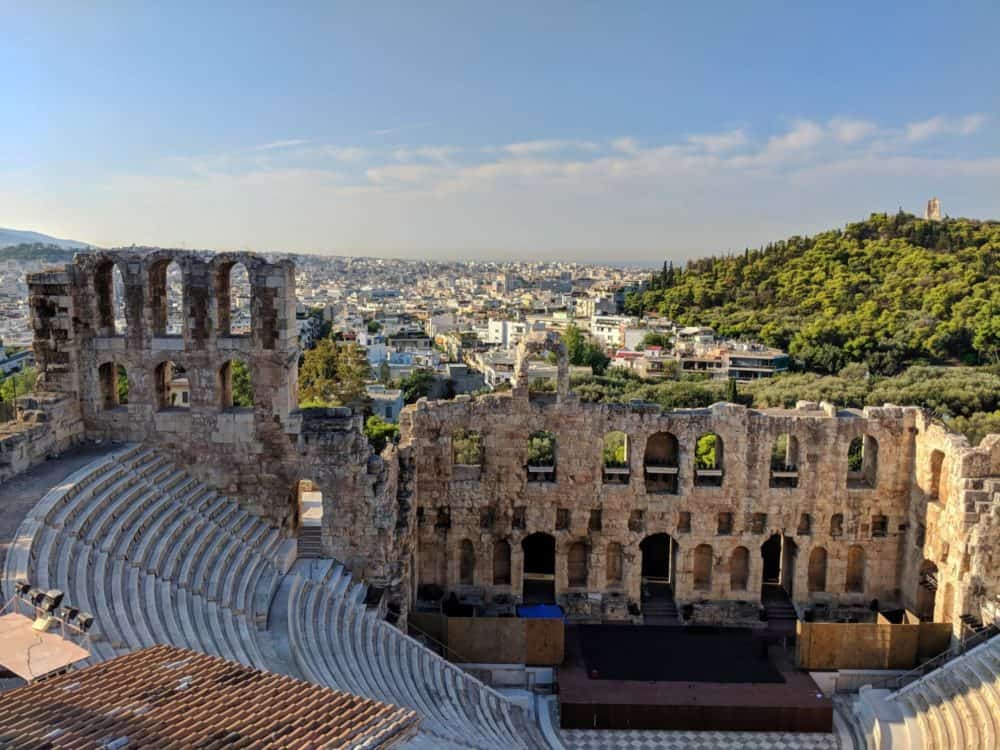
We’d walked straight past the Temple of Dionysus on the way in, and looked over the top of the Odeon of Herodes Atticus. They’d both be major attractions in their own right anywhere else in the world, and returning to them on the way back down meant we could explore at a much more leisurely pace.
While the Odeon was still fairly busy by the time I got there, it wasn’t a patch on the flash mob I’d left at the top. The Temple of Dionysus was almost deserted, which was a wonderful surprise.
Don’t Forget the Acropolis Museum
The old Acropolis Museum used to be housed onsite, at the top of the hill. In 2009, however, it moved to a brand-new building nearby on Dionysiou Areopagitou. It’s very close to the side entrance that I recommend above, so if you exit where you came in, you’ll have no trouble finding it.
Entry to the Acropolis Museum costs €10 in summer, and it’s worth every cent. The museum is not covered by the Athens multi-site ticket, but like the ancient sites, discounts are available in winter and for various groups.
The lines were short when we arrived mid-morning, but longer when we left a couple of hours later. They moved fast, though, and while you can book in advance to skip the ticket line, you probably don’t have to unless you’re there during peak tourist season.
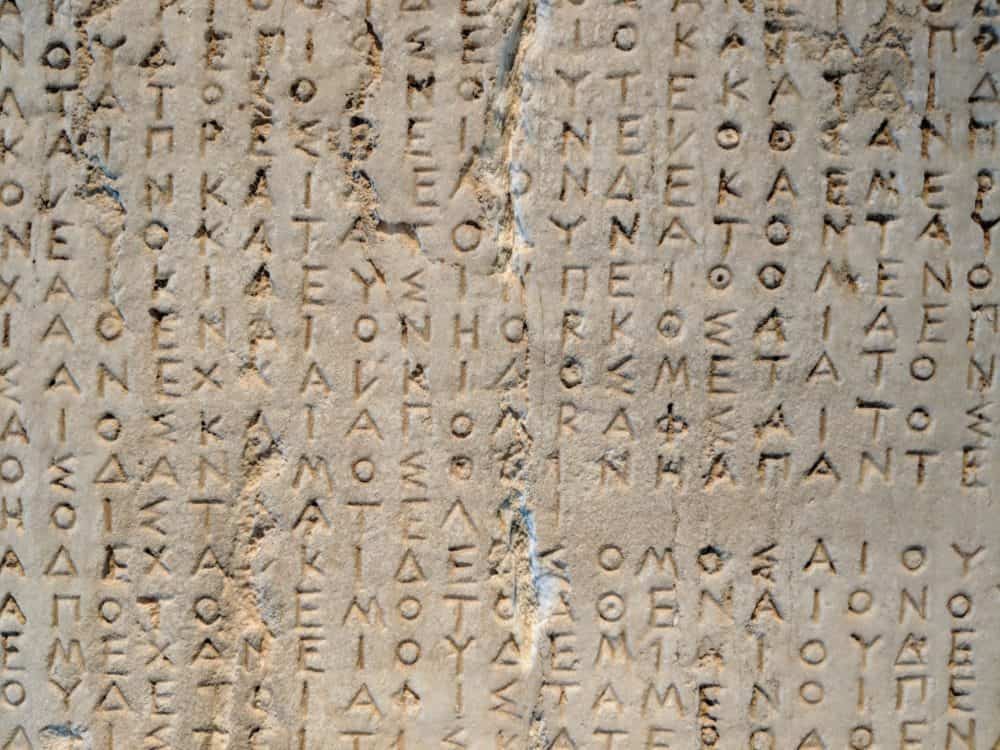
Full of art, artifacts, statues, archaeological remains, and much more from the top and slopes of the Acropolis, there’s a lot to see inside. Two floors are devoted to the permanent exhibits, while the other two house temporary exhibitions, multimedia galleries, cafes, shops, and restaurants. In summer, the air conditioning is very welcome!
Between the Acropolis and the Museum, it’s easy to spend an entire morning in the area. Unless you’re really in a hurry, don’t rush either of them.
So there you have it, my top tips for visiting the Acropolis in Athens. Have a great time!

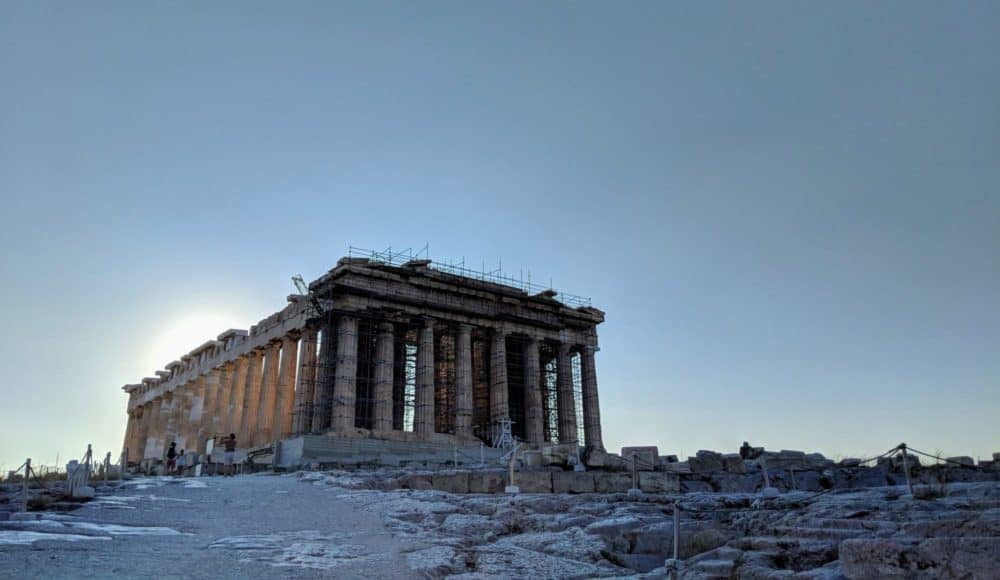
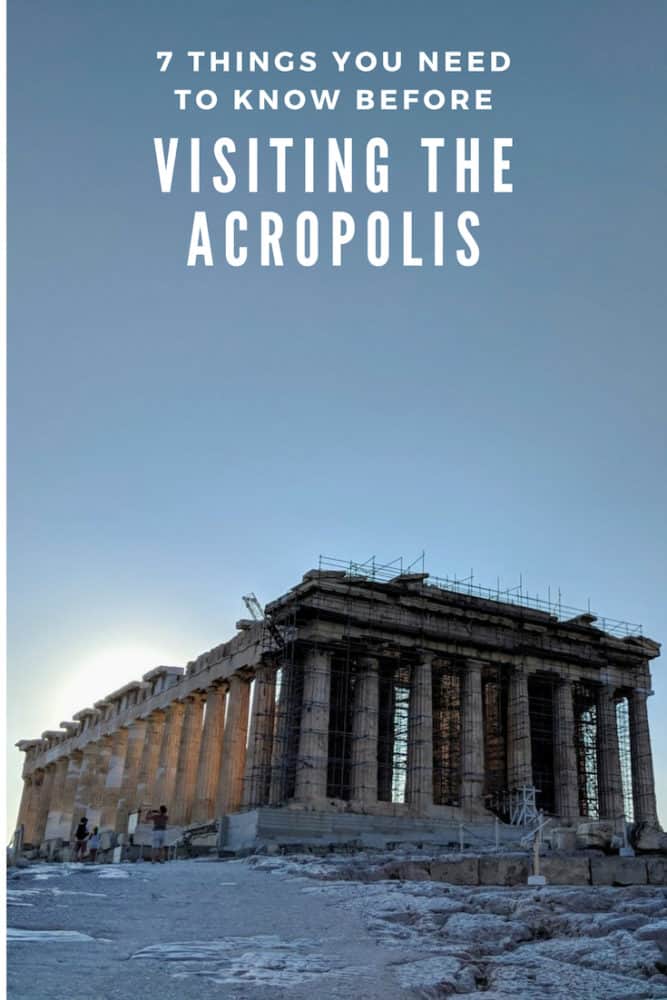

Thanks for all this useful information Dave! I’m planning a trip to Athens in a couple of months, this comes at the perfect timing. 🙂
Would you have other suggestions of other must-see places in Athens?
And any restaurant that you particularly enjoyed?
Many thanks!
Funnily enough this piece started off as a more general guide to Athens, and then the Acropolis section got so big that I split it out into a separate post. Hopefully I’ll get around to writing up the rest of it before long!
Hi Dave,
just wanted to thank you again for the advise on how to plan the visit the Acropolis. I followed your advice step by step and it was great!
We didn’t manage to arrive to the top to have the place entirely for ourselves, other people walked faster than us, but still were able to visit without crowds, at least for around 15 min. By the time we left it was so full it wasn’t pleasant anymore and too hot to be under the sun anyway.
So glad it was useful!
Dave thanks for the wonderful post. I was literally walking through the Acropolis. I am planning to visit this April 2020.
Dave – this information is very much appreciated. My son who is 23 has always wanted to see the Acropolis and so I am going with him in May (if Covid allows). This trip will mean a lot to us – one to tick off the ole bucket list, so getting these tips is really great. We are not ones for walking round museums but feel we should have a wander around the museum while we are there and, as you said, it was worth every cent.
Thanks Dave! I am planning a trip with my family in mid-July and I will follow your advice. I do have a question for you, would you recommend taking a tour (small group) to visit the Acropolis?
Thanks again
If you’d like to learn more about the history and architecture without having to do a whole lot of research yourself ahead of time, it might be worth it for you. I didn’t take one, though, so can’t recommend a particular company.
Hi Dave,
I am planning a trip to Greece/Athens in September. Some of my family is vaccinated against Covid-19 and others are not due to medical reasons. Those that are not vaccinated don’t mind masks or being tested. I don’t see any information regarding Covid guidelines to get into the Acropolis. Do you know of any? It would be rather pointless to go to Greece and not go to the ancient ruins and the Acropolis.
You have great information, I hope we can go!
I don’t know the current requirements, I’m afraid — and I suspect that any rules that are in place at the moment will change at least a dozen times before September anyway! Hopefully the trip works out for everyone!
Thanks for all the great information. I’m trying to work out which tickets to buy. I have two children who are eligible for free tickets. I believe I can’t pre book these tickets, but that I get them from the ticket office on the day. What I can’t work out is if I will have to wait in the main ticket queue (in which case it’s pointless pre booking the adult tickets), or whether there is any fast track if I just want to collect the free tickets. Would you happen to know anything about this? Thank you
I don’t remember seeing a fast-track sign or option at the ticket gate I went through, although since that’s not the main entrance, maybe they wouldn’t have one anyway. Maybe someone else who reads this can chime in if they happen to know for sure. 🙂
Hi Dave,
What would you say about trying to visit the Acropolis later in the day? Is there a time that the tours tend to leave? It sounds like those who are getting there half an hour earlier still only get around 15 min to themselves…and we also have a little baby meaning it would be harder to get early enough to get to the top before the crowds arrive. Is there a period of time around 5 when there’s not as many people but there’s still enough time to see things before everything is closed down? Thank you!
Sincerely,
Jay
Yeah, the crowds tend to thin out a bit later in the day as you suggest. The issue (in summer, at least) is more likely to be heat: it’s often still seriously hot at 5pm, and there’s essentially zero shade up there. If you’re going in spring or autumn/fall, though, or on a day in summer where it happens to not be super hot, it’s not a bad option.
Hello, if you are there for 0730, is the side entrance still better? It looks like the side entrance is 600 meters from the main gateway vs 100 meters from the main entrance and I’m wondering if it really is so crowded that you cannot get there faster from the main entrance if you’re there first thing in the morning.
We’re going the end of May and would go in the evening if knew it would be less busy.
Thank you for your help!
It’s up to you. If you get there before everyone else does, it’ll be quicker from the main entrance — but that’s a big if most of the time. It’s not the walking distance from the ticket gates that you’re avoiding by using the side entrance, it’s the long line of people in front of you waiting to get in.
That said, late May isn’t peak time, so you might be fine. It’s also quieter later in the day, and it shouldn’t be unbearably hot in Athens in the evening at that time of year, so going at the end of the day is a more viable option.
Thanks Dave, I really appreciate you sharing your experience!
Hello, your post is really helpful! I read on another site that the side entrance was less busy because it was “only designated for small tours”…but I guess you’re saying they do also allow single visitors in that entrance? If we purchase tickets online ahead of time, is there a way to show the digital tickets at that side entrance to enter, or do we need to “exchange” for a real ticket? Trying to avoid any long lines if possible! We will be arriving just before opening time.
I’m assuming that the other site meant that only small tour groups could use it, rather than large ones — but yes, single visitors are fine as well. There were no tours of any sort that I could see when I was there at opening time.
I mentioned it in the article, but when buying your advance ticket, you have the choice of a physical one that you do need to exchange, or a mobile ticket that you don’t. This is the link to the mobile version.
Hi Dave
Apparently this is the gift that keeps on giving! Very useful info long after you wrote it. Thanks so much.
Another Dave
Great advice! We got to the queue and whilst we weren’t first up it was way quieter than a short while later. Thanks!